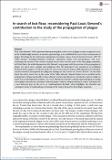Files in this item
In search of lost fleas : reconsidering Paul-Louis Simond’s contribution to the study of the propagation of plague
Item metadata
| dc.contributor.author | Lynteris, Christos | |
| dc.date.accessioned | 2023-01-18T09:30:06Z | |
| dc.date.available | 2023-01-18T09:30:06Z | |
| dc.date.issued | 2023-01-17 | |
| dc.identifier | 280111478 | |
| dc.identifier | 6f211b5c-9e0b-4817-82f2-215904ff5758 | |
| dc.identifier | 000917937600004 | |
| dc.identifier | 85146842005 | |
| dc.identifier.citation | Lynteris , C 2023 , ' In search of lost fleas : reconsidering Paul-Louis Simond’s contribution to the study of the propagation of plague ' , Medical History , vol. 66 , no. 3 , pp. 242–263 . https://doi.org/10.1017/mdh.2022.19 | en |
| dc.identifier.issn | 0025-7273 | |
| dc.identifier.other | ORCID: /0000-0001-8397-0050/work/127066263 | |
| dc.identifier.uri | https://hdl.handle.net/10023/26766 | |
| dc.description | Funding: Research leading to this article was funded by the Wellcome Trust [Grant No. ID 217988/Z/19/Z] for the project ‘The Global War Against the Rat and the Epistemic Emergence of Zoonosis’. | en |
| dc.description.abstract | Paul-Louis Simond’s 1898 experiment demonstrating fleas as the vector of plague is today recognised as one of the breakthrough moments in modern epidemiology, as it established the insect-borne transmission of plague. Providing the first exhaustive examination of primary sources from the Institut Pasteur’s 1897–98 ‘India Mission’, including Simond’s notebooks, experiment carnets and correspondence, and cross-examining this material with colonial medical sources from the first years of the third plague pandemic in British India, the article demonstrates that Simond’s engagement with the question of the propagation of plague was much more complex and ambiguous than the teleological story reproduced in established historical works suggests. On the one hand, the article reveals that the famous 1898 experiment was botched, and that Simond’s misreported its ambiguous findings for the Annales de l’Institut Pasteur. On the other hand, the article shows that, in the course of his ‘India Mission’, Simond framed rats as involved in the propagation of plague irreducibly in their relation to other potential sources of infection and not simply in terms of a parasitological mechanism. The article illuminates Simond’s complex epidemiological reasoning about plague transmission, situating it within its proper colonial and epistemological context, and argues for a new historical gaze on the rat as an ‘epidemiological dividual’, which highlights the relational and contingent nature of epidemiological framings of the animal during the third plague pandemic. | |
| dc.format.extent | 22 | |
| dc.format.extent | 456290 | |
| dc.language.iso | eng | |
| dc.relation.ispartof | Medical History | en |
| dc.subject | Plague | en |
| dc.subject | Institut Pasteur | en |
| dc.subject | Rat | en |
| dc.subject | Experiment | en |
| dc.subject | India | en |
| dc.subject | GN Anthropology | en |
| dc.subject | RA0421 Public health. Hygiene. Preventive Medicine | en |
| dc.subject | T-NDAS | en |
| dc.subject | SDG 3 - Good Health and Well-being | en |
| dc.subject | MCC | en |
| dc.subject.lcc | GN | en |
| dc.subject.lcc | RA0421 | en |
| dc.title | In search of lost fleas : reconsidering Paul-Louis Simond’s contribution to the study of the propagation of plague | en |
| dc.type | Journal article | en |
| dc.contributor.sponsor | The Wellcome Trust | en |
| dc.contributor.institution | University of St Andrews. Social Anthropology | en |
| dc.identifier.doi | 10.1017/mdh.2022.19 | |
| dc.description.status | Peer reviewed | en |
| dc.identifier.grantnumber | 217988/Z/19/Z | en |
This item appears in the following Collection(s)
Items in the St Andrews Research Repository are protected by copyright, with all rights reserved, unless otherwise indicated.

